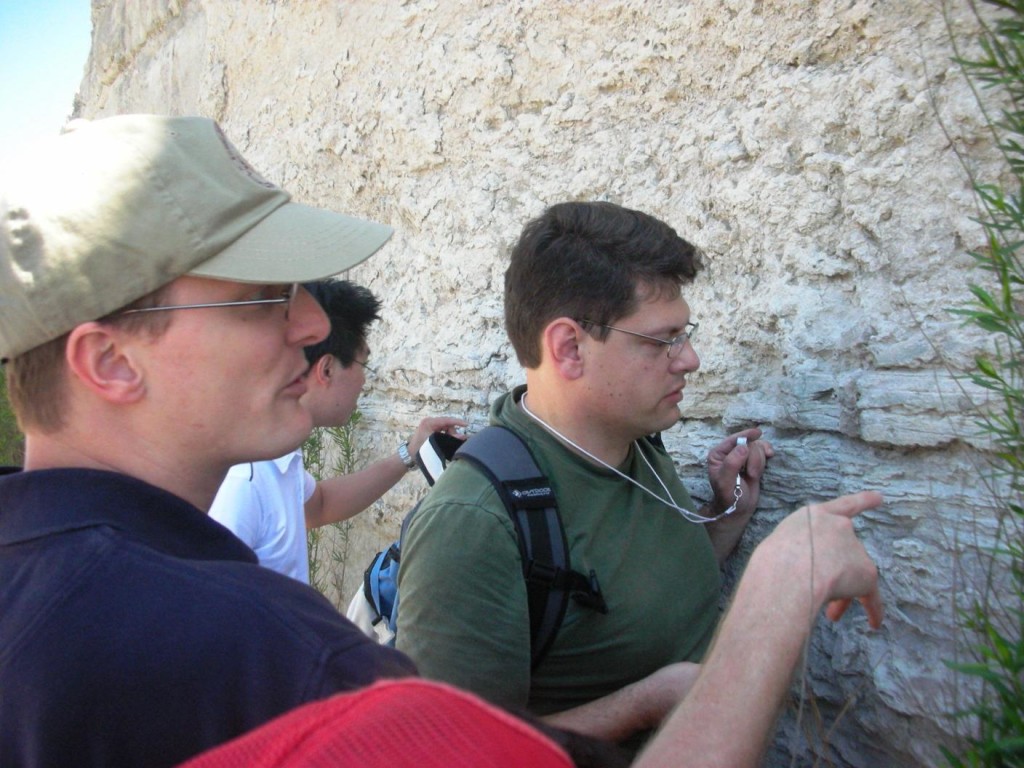Conference registration is required for enrollment in field trips and short courses, with the exception of the More! Rocks in Your Head teacher program. See the Registration page for details on registration options. Save with Early Bird rates until August 16th!

Dr. Joel Saylor
Dr. Joel Saylor, of University of Houston, will take field trip members to incredible stops near Canyon Lake, Texas, where the Cretaceous Glen Rose limestone has dinosaur footprints. Canyon Lake Gorge is over 1 mile long, hundreds of yards wide, and 50 feet or more deep. The outcrops are exposed in the Texas Hill Country near Canyon Lake dam about 20 miles northwest of New Braunfels, Texas. The 115-105 million-year-old limestone was deposited in a shallow marine to shoreline paleo-environment. Participants will see track ways of two different dinosaur species, marine fossils including bivalves, corals, large foraminifera, echinoderms, gastropods and rudists. Structural geology stops will show Miocene-age normal fault features related to the Balcones fault zone. This will be a one-day field trip leaving the Hilton Americas at 8:30 am and returning 6:30 pm, Saturday, September 19, 2015.
Maximum number of participants: 21 (4 Student spots)
Cost: $100 per person; $25 for students (includes transportation, lunch and refreshments, guidebook, and admission fee)
On July 4, 2002 rain had filled the Canyon Lake Reservoir and the water began to overtop the Emergency Spillway. The spillway, designed for a maximum release of 5,000 cubic feet per second, had been completed in 1964 and had never been overtopped. On that day, the 34 inches of rain that fell in the upper Guadalupe River watershed in the previous week cascaded over the spillway at 67,000 cfs. The flood scoured the gorge downstream of the spillway, exposing the Cretaceous Glen Rose Formation and a portion of the Balcones fault sytem: the Hidden Valley Fault Zone. In this now pristine bedrock gorge we will explore how post-depositional dissolution and fault-related fracturing enhance porosity and guide fluid flow as an analog for carbonate reservoirs.
On this field trip we will explore the depositional environments of the Glen Rose Formation which is composed of limestone, dolostone, and interbedded marl and and calcareous shale. The lower Glen Rose Formation (below the regionally extensive Corbula bed) consists of cycles of intertidal to sub-tidal micrite and boundstone that shoals upward into a bored hardground. The upper Glen Rose Formation continues the upward shoaling trend: cycling between subtidal and supratridal fossiliferous micrites, wackestones, and grainstones. The grainstone facies are high-quality reservoirs and the reservoir quality it further enhanced by post-depositional dissolution and fracturing associated with the Hidden Valley Fault zone.
The Hidden Valley Fault zone is a series of interconnected synthetic and antithetic faults accommodating down-to-the-east movement. Throw across the fault is 55–63 m. The Hidden Valley Fault zone defies established relationships on a number of counts. Joint to fault ratios are orders of magnitude lower than typically assumed relationships. Damage extends into both the footwall and hanging wall, with higher-density fracturing extending further into the footwall than into the hanging wall. Further, there is no clear increase in jointing approaching the fault core. Disappearing and reemerging streams along the fault zone point to localization of subsurface fluid flow along fractures as a potential analog for carbonate reservoirs modified by post-depositional dissolution and fracturing.
<<Back to Field Trips Overview

Glen Rose Limestone Outcrops